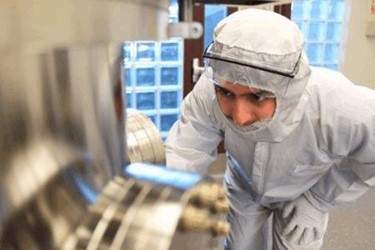Ohio State Researchers Design 'Hovering' Millimeter Wave Antennas
By Jof Enriquez,
Follow me on Twitter @jofenriq

Researchers at Ohio State University’s ElectroScience Laboratory (ESL) are designing "hovering" or suspended high-gain millimeter-wave antenna arrays that boost wireless signals and alleviate the crowded electromagnetic frequency spectrum.
Millimeter waves (30-300 GHz) provide the "continuous bandwidth" capability required for future high-bandwidth, high-speed data transmission, which crowded lower frequencies are finding increasingly difficult to provide as interconnected devices proliferate with higher bandwidth demand.
"Nowadays, we use cellphones for all sorts of wireless communication for voice and video transmission," said Nima Ghalichechian, an assistant professor in electrical and computer engineering, who leads the project. "There is a need and a growth every year. Every year we need a lot more [signal strength] to send and receive more data than the previous year."
Beaming millimeter waves over the air, as compared to more costly fiber-optic cabling, could be key to next-generation broadband infrastructure, particularly cellular communications in urban environments.
"We are trying to go about 50 times higher frequency to get us 50 times higher bandwidth," Ghalichechian said. "So, the idea is to create devices that transmit and receive data at these very high frequencies."
Ghalichechian's team is designing suspended high-gain millimeter-wave antenna arrays constructed through hybrid fabrication using MEMS (Micro-Electro-Mechanical Systems) and 3D-printing technologies.
"Think of it like a diaphragm supported by small posts, but it’s mostly floating. The idea is to physically isolate the antenna from the lossy substrate. Suspend it in air," said Ghalichechian, referring to losses attributed to traditional silicon substrates the antenna is mounted on, a set-up that tends to weaken wireless signals.
In order to address this well-established limitation in antenna design, "The central objective is to develop scanning arrays on silicon integrated circuits that exhibit radiation efficiency of greater than 85 percent. Such compact high-efficiency millimeter-wave arrays have not been realized to date."
For the lens components attached to the antenna, graduate research assistants Jiantong Li and Kyoung Ho Jeong, are experimenting with new 3D-printing technologies. Their aim is to build lensing structures which focus and amplify signals generated by the suspended antenna array.
Ghalichechian and his team of students received recently a three-year $300,000 National Science Foundation (NSF) grant award to further develop their miniaturized "hovering" antennas. Aside from from millimeter-wave applications, these unique antennas are intended for short-range communication links, satellite communications, radars, remote sensing, security, and medical imaging.
